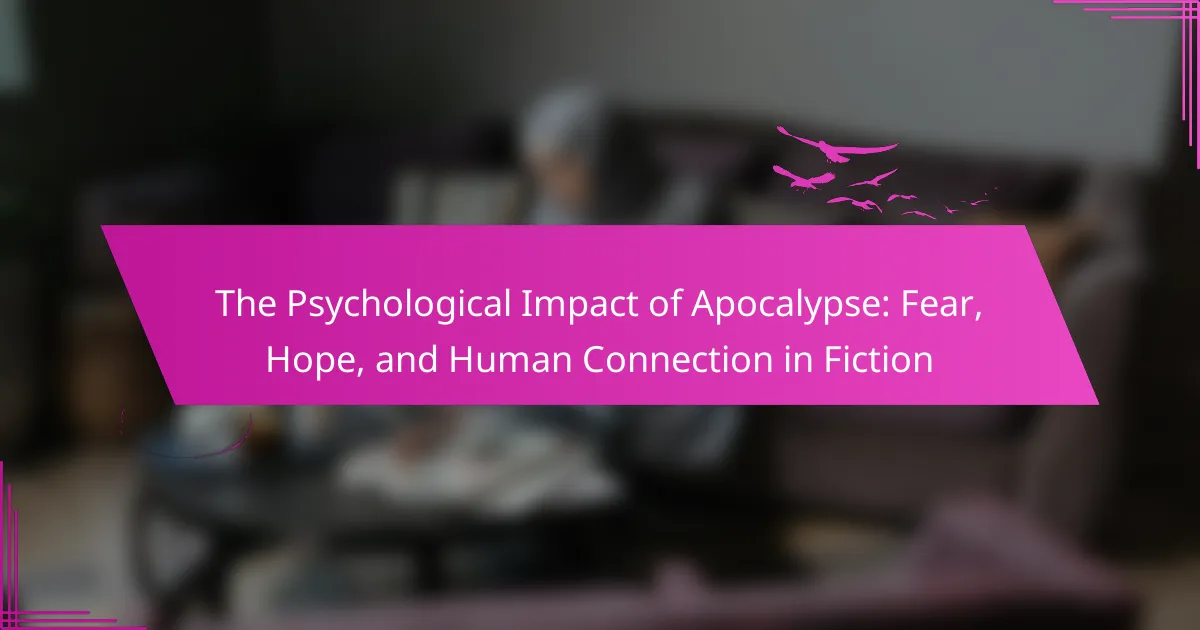Apocalyptic fiction explores the psychological impact of fear, hope, and human connection. It delves into human vulnerability and resilience amid societal collapse. The narratives highlight the importance of relationships as a counterbalance to despair. Additionally, they reflect real-world anxieties about uncertainty and survival, fostering community and cooperation.
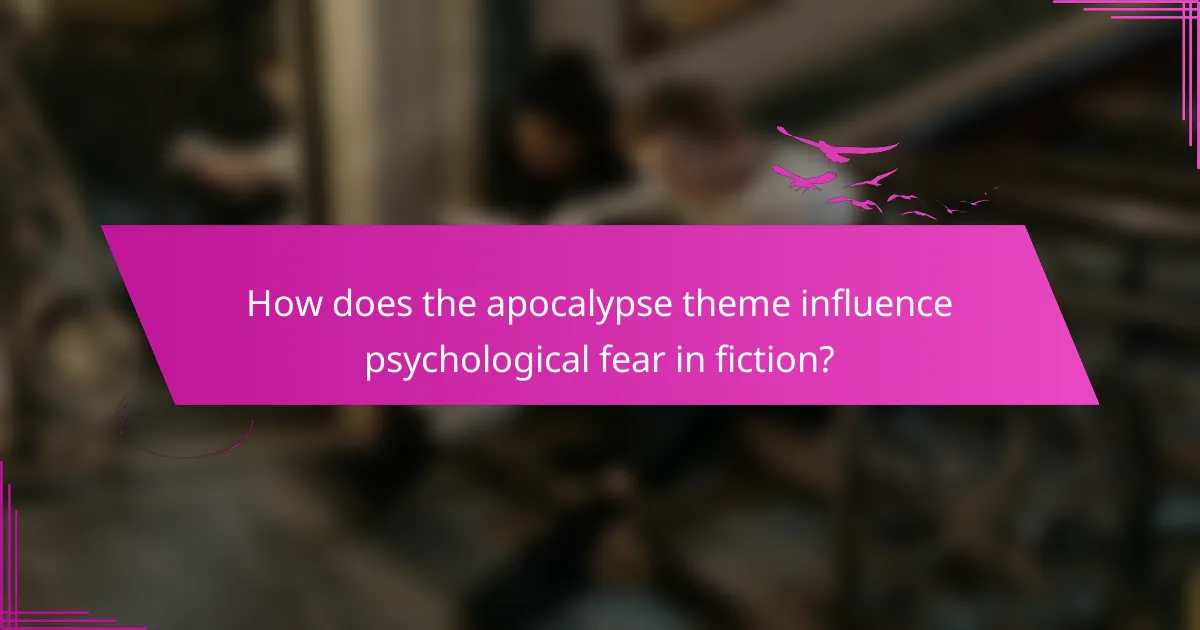
How does the apocalypse theme influence psychological fear in fiction?
The apocalypse theme profoundly influences psychological fear in fiction by exploring human vulnerability and resilience. It evokes existential dread while simultaneously highlighting hope and connection among characters. This duality fosters a rich emotional landscape, allowing readers to confront their fears in a controlled environment. The portrayal of societal collapse often serves as a backdrop for personal growth, emphasizing the importance of relationships. As a result, narratives centered on apocalypse themes resonate deeply, reflecting real-world anxieties about uncertainty and survival.
What are common fears depicted in apocalyptic narratives?
Common fears in apocalyptic narratives include loss of control, isolation, and the collapse of societal norms. These fears reflect deep-seated anxieties about survival and human connection. Characters often grapple with the fear of the unknown, facing existential threats that challenge their morality and relationships. Additionally, the fear of failure to protect loved ones intensifies emotional turmoil, showcasing the psychological impact of dire circumstances.
How do different cultures interpret fear in apocalypse stories?
Different cultures interpret fear in apocalypse stories through unique lenses shaped by their histories and beliefs. For instance, in Western narratives, fear often stems from existential threats, reflecting individualism and personal survival. In contrast, Eastern interpretations may focus on community resilience and collective hope, emphasizing human connection amidst chaos. Additionally, indigenous cultures frequently incorporate spiritual elements, viewing apocalyptic scenarios as opportunities for rebirth rather than mere destruction. These diverse perspectives illustrate how cultural contexts shape the emotional responses elicited by apocalyptic fiction, highlighting the interplay between fear and hope in human storytelling.
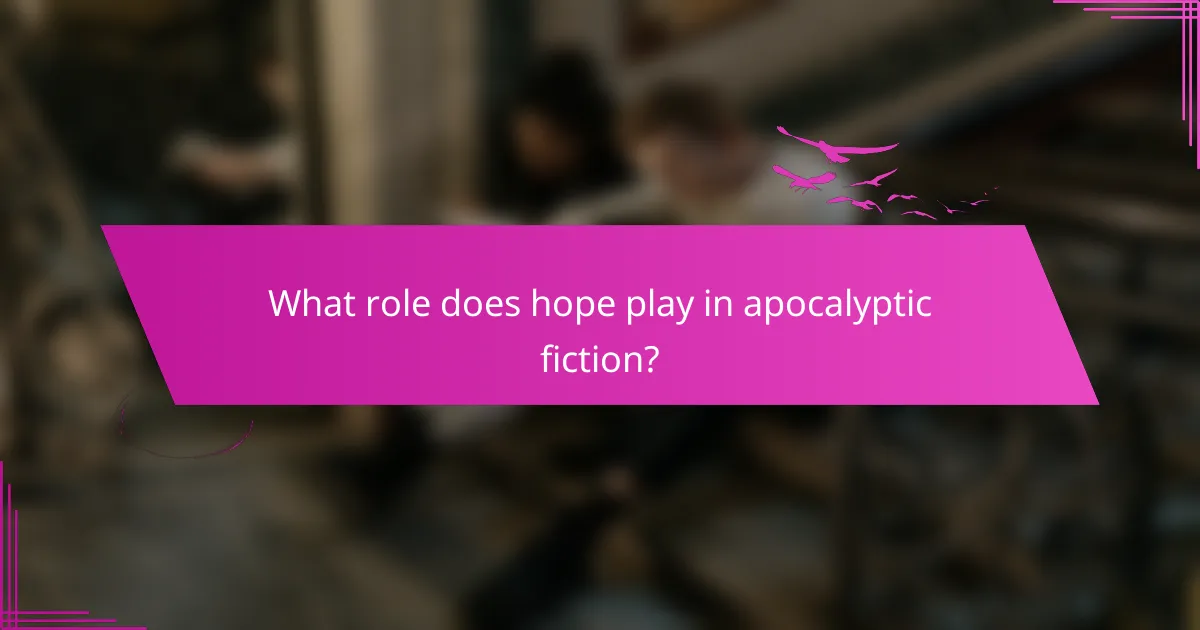
What role does hope play in apocalyptic fiction?
Hope serves as a crucial counterbalance to despair in apocalyptic fiction. It fosters resilience, encouraging characters and readers to envision a future beyond devastation. This psychological aspect enhances human connection, illustrating how hope can unite individuals amid chaos. In many narratives, hope drives character motivations, influencing their actions and decisions. For instance, protagonists often cling to hope as a means of survival, showcasing its power to inspire courage and foster community. Ultimately, hope in these stories reflects a fundamental human need for meaning and connection, even in the bleakest circumstances.
How do characters embody hope amidst despair?
Characters embody hope amidst despair by showcasing resilience and fostering human connection. In apocalyptic narratives, their journeys often highlight the struggle against overwhelming odds. For instance, protagonists may form bonds that symbolize strength and optimism, countering the pervasive fear of their environments. This dynamic reinforces the notion that hope can thrive even in dire circumstances, serving as a crucial psychological anchor for both characters and readers. Ultimately, these stories illustrate how human connection becomes a beacon of hope, illuminating paths through darkness.
What are the psychological benefits of hope in dystopian settings?
Hope in dystopian settings fosters resilience, enhances emotional well-being, and strengthens social bonds. It serves as a psychological buffer against despair, motivating individuals to envision a better future. Hopeful characters often inspire collective action, promoting unity in adversity. This dynamic illustrates how hope can transform fear into determination, allowing individuals to navigate bleak circumstances with a sense of purpose.
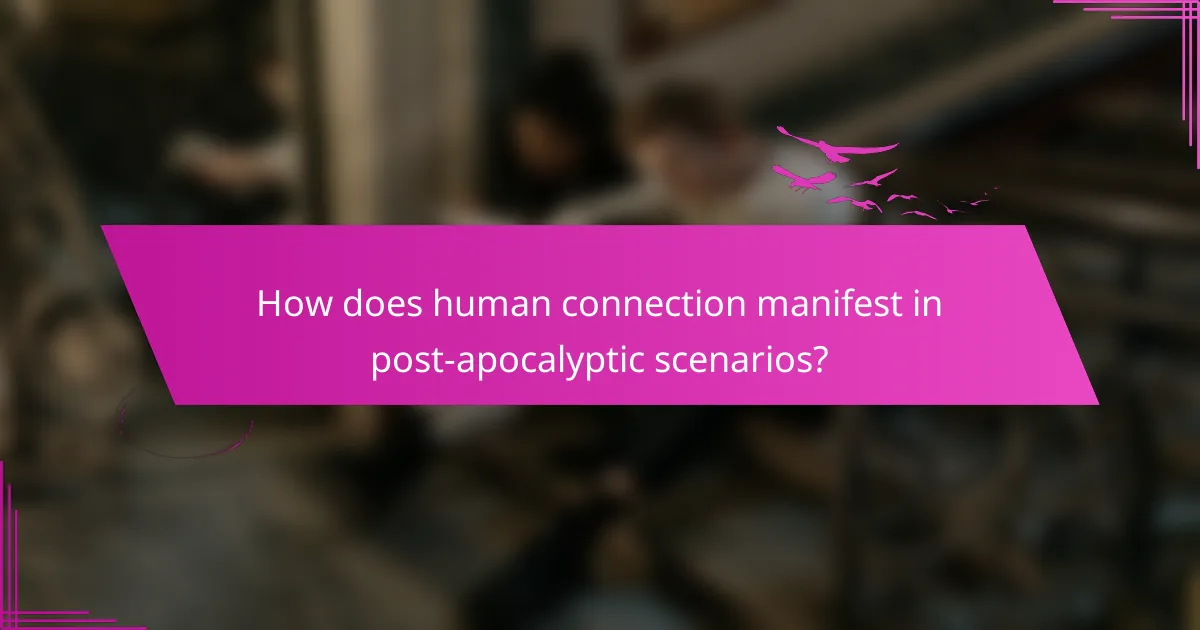
How does human connection manifest in post-apocalyptic scenarios?
Human connection in post-apocalyptic scenarios often emerges as a survival mechanism, fostering resilience and hope. Characters typically form deep bonds through shared experiences, which counteract isolation and despair. These connections manifest through acts of kindness, cooperation, and mutual support, highlighting humanity’s inherent need for social interaction even in dire circumstances. As a result, relationships become vital for emotional survival, providing strength against fear and uncertainty.
What types of relationships are formed in apocalyptic fiction?
Apocalyptic fiction often explores complex relationships shaped by fear, hope, and survival instincts. Key types of relationships include:
1. **Survival Partnerships**: Characters form alliances based on necessity, relying on each other for safety and resources.
2. **Familial Bonds**: Family dynamics are heightened, showcasing love and conflict as characters navigate trauma.
3. **Romantic Connections**: Intimacy emerges as a response to despair, highlighting human resilience and the need for companionship.
4. **Community Ties**: Groups unite for collective survival, fostering a sense of belonging amid chaos.
5. **Antagonistic Relationships**: Conflicts arise between groups or individuals, often reflecting moral dilemmas and the struggle for power.
These relationships illustrate the psychological impact of apocalyptic scenarios, emphasizing human connection amidst adversity.
How do these connections affect character development and survival?
Connections significantly enhance character development and survival in apocalyptic fiction. Fear and hope drive characters to forge bonds, impacting their resilience. Relationships provide emotional support, fostering adaptability in dire circumstances. Characters often evolve through shared experiences, revealing unique traits and survival strategies. Ultimately, human connection becomes a crucial element for overcoming challenges and navigating the psychological landscape of an apocalypse.
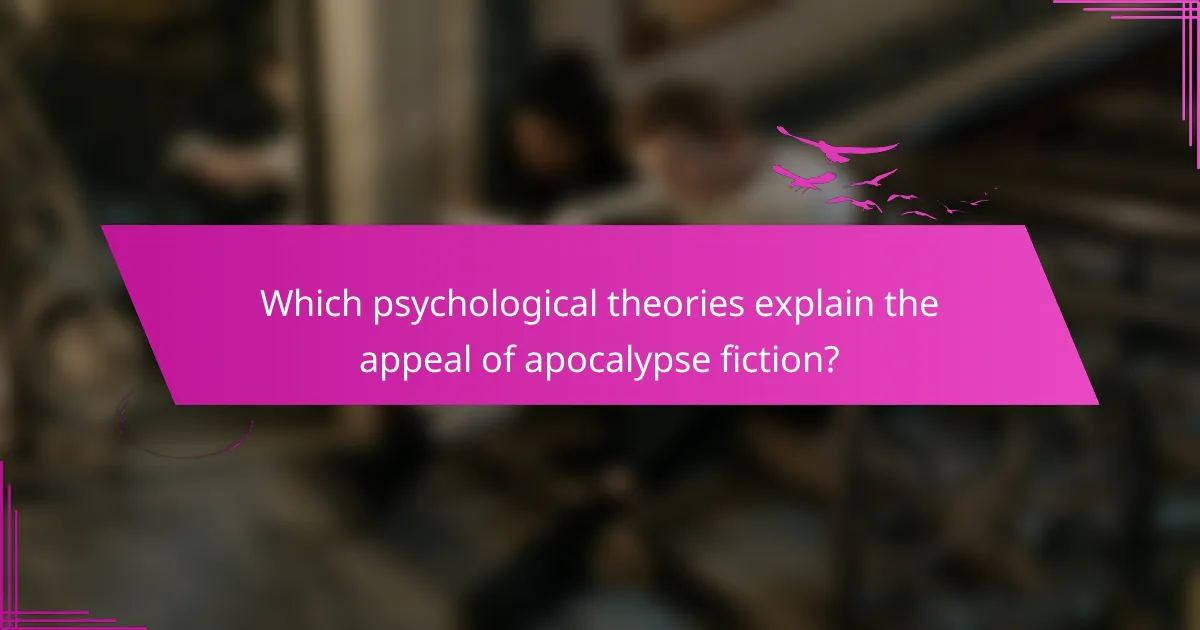
Which psychological theories explain the appeal of apocalypse fiction?
Psychological theories explaining the appeal of apocalypse fiction include existentialism, which highlights human fears and hopes in facing mortality. This genre often evokes feelings of fear, prompting reflection on societal values and individual resilience. The shared experience of crisis fosters human connection, emphasizing community and cooperation. Additionally, narrative escapism allows audiences to confront real-world anxieties in a controlled environment, providing catharsis and a sense of agency.
How does escapism relate to the consumption of apocalyptic narratives?
Escapism in apocalyptic narratives offers a refuge from reality, allowing individuals to confront fears while fostering hope. These stories often explore themes of survival, resilience, and human connection. Engaging with such narratives can provide emotional catharsis, enabling readers to process anxieties about the future. The unique attribute of apocalyptic fiction lies in its ability to blend fear with optimism, creating a complex emotional landscape that resonates with audiences. This interplay encourages reflection on personal and societal challenges, ultimately enhancing the understanding of human relationships in times of crisis.
What role does catharsis play in the audience’s experience?
Catharsis plays a crucial role in the audience’s experience by providing emotional release and relief. In apocalyptic fiction, characters face extreme fear and despair, prompting viewers to confront their own anxieties. This shared emotional journey fosters a sense of hope and connection among the audience. As a result, catharsis enhances engagement, allowing individuals to process complex feelings in a safe environment. Ultimately, this psychological impact deepens their appreciation of the narrative and its themes.
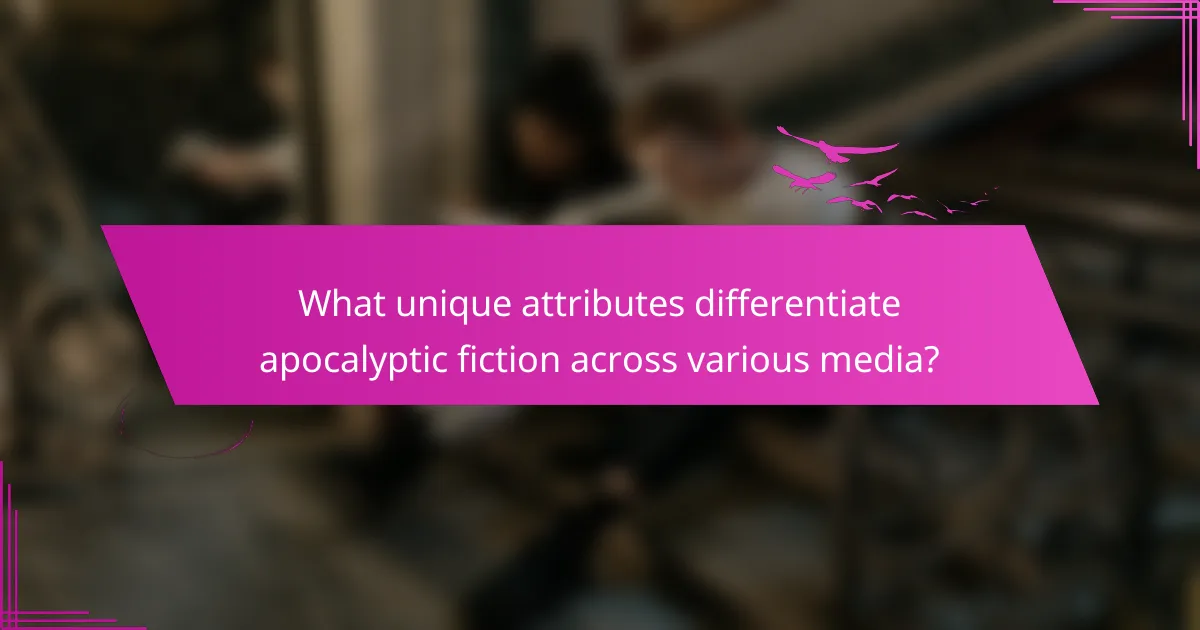
What unique attributes differentiate apocalyptic fiction across various media?
Apocalyptic fiction varies across media through unique attributes such as narrative structure, character development, and thematic exploration. Each medium offers distinct ways to convey psychological impacts like fear, hope, and human connection.
In literature, internal monologues deepen character psychology, while films often rely on visual storytelling to evoke immediate emotional responses. Video games provide immersive experiences, allowing players to explore apocalyptic worlds and make impactful choices.
The exploration of human connection varies; novels may focus on interpersonal relationships through dialogue, while graphic novels use imagery to highlight emotional states. Each medium’s unique approach shapes audience perceptions of the apocalypse and its psychological effects.
Moreover, rare attributes like the use of unreliable narrators in literature or interactive storytelling in games create diverse experiences, enhancing the overall impact of apocalyptic themes.
How do films portray apocalypse differently than novels?
Films often portray apocalypse through visual spectacle and immediate sensory experiences, while novels delve deeper into psychological nuances and character development. This difference shapes the audience’s emotional response, emphasizing fear and hope in distinct ways.
In films, rapid pacing and visual effects create a sense of urgency, often prioritising action over introspection. This can lead to a more superficial understanding of human connections during catastrophic events. Conversely, novels utilise internal monologues and detailed narratives to explore the psychological impact of apocalypse, fostering a deeper emotional engagement with characters’ fears and hopes.
Moreover, films frequently rely on archetypal characters and dramatic visuals to convey themes, whereas novels can present complex character arcs and moral dilemmas. This depth allows readers to reflect on the human condition and societal structures more profoundly than viewers might experience in a film.
Ultimately, while both mediums address the apocalypse’s psychological impact, films focus on immediate emotional reactions, while novels provide a more comprehensive exploration of human connection and resilience.
What are the unique storytelling techniques used in graphic novels about apocalypse?
Graphic novels about apocalypse employ unique storytelling techniques that evoke psychological responses. They often blend visual imagery with narrative depth to explore themes of fear, hope, and human connection.
One technique is the use of juxtaposition, contrasting bleak scenarios with moments of resilience. This highlights the fragility of hope amidst despair. Additionally, non-linear storytelling can immerse readers in fragmented realities, mirroring the chaos of an apocalyptic world.
Visual metaphors enhance emotional resonance, allowing readers to engage with complex themes subtly. For instance, imagery of decaying cities can symbolise lost connections, while vibrant colours in moments of human triumph can signify hope.
Character development is crucial; protagonists often face moral dilemmas that reflect inner fears and desires. This deepens the reader’s connection to the narrative, illustrating how human relationships endure even in dire circumstances.
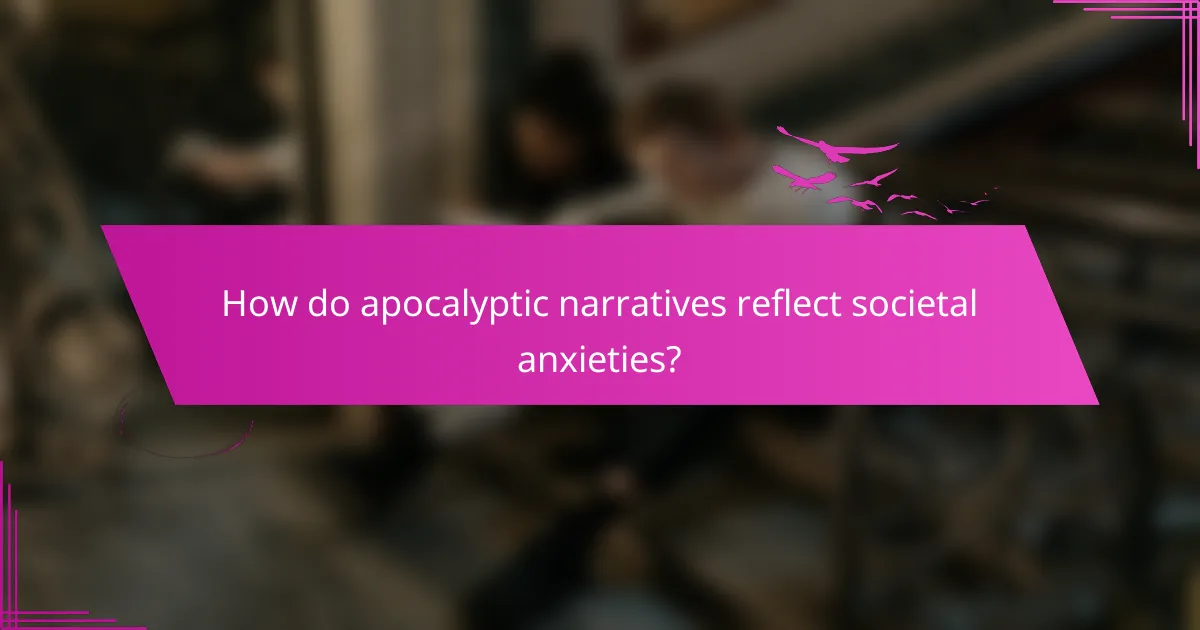
How do apocalyptic narratives reflect societal anxieties?
Apocalyptic narratives reflect societal anxieties by illustrating fears of collapse and loss while simultaneously offering hope and connection. These stories often highlight existential threats, such as climate change or pandemics, mirroring real-world concerns. They allow audiences to explore human resilience and community bonds during crises, fostering a sense of shared experience. This duality of fear and hope enables deeper psychological engagement, as individuals confront their anxieties in a fictional context, promoting discussions about survival and morality.
What current global issues are mirrored in recent apocalyptic fiction?
Recent apocalyptic fiction reflects current global issues such as climate change, pandemics, and social inequality. These narratives explore the psychological impact of fear and hope, emphasizing human connection amidst chaos.
Climate change is a prevalent theme, showcasing environmental collapse and its effects on society. Characters often grapple with despair yet find resilience through community bonds.
Pandemics in fiction mirror real-world health crises, illustrating societal breakdown and individual struggles. Hope emerges as characters unite to combat adversity, fostering connections that highlight humanity’s strength.
Social inequality is another critical issue depicted in these stories. The disparity between privileged and marginalised groups becomes pronounced during apocalyptic scenarios, prompting reflections on justice and solidarity.
These themes engage audiences by resonating with contemporary anxieties, ultimately offering a lens through which to examine resilience and connection in the face of existential threats.
How do these narratives shape public perception of real-world crises?
Narratives about apocalyptic scenarios significantly shape public perception of real-world crises by eliciting emotions of fear and hope. These stories often highlight human resilience, fostering a sense of connection among individuals facing uncertainty.
Fictional portrayals of apocalypse can amplify anxieties about global issues, such as climate change or pandemics. By dramatizing potential futures, these narratives serve as cautionary tales, urging society to take action. As a result, people may feel more compelled to engage in community efforts or support policy changes.
Conversely, apocalyptic narratives can inspire hope by showcasing humanity’s capacity for survival and innovation. They often depict characters overcoming adversity, suggesting that even in dire circumstances, positive outcomes are possible. This duality of fear and hope encourages public discourse on preparedness and collective action.
Ultimately, the psychological impact of these narratives can lead to increased awareness and solidarity, prompting a more proactive approach to addressing real-world crises.
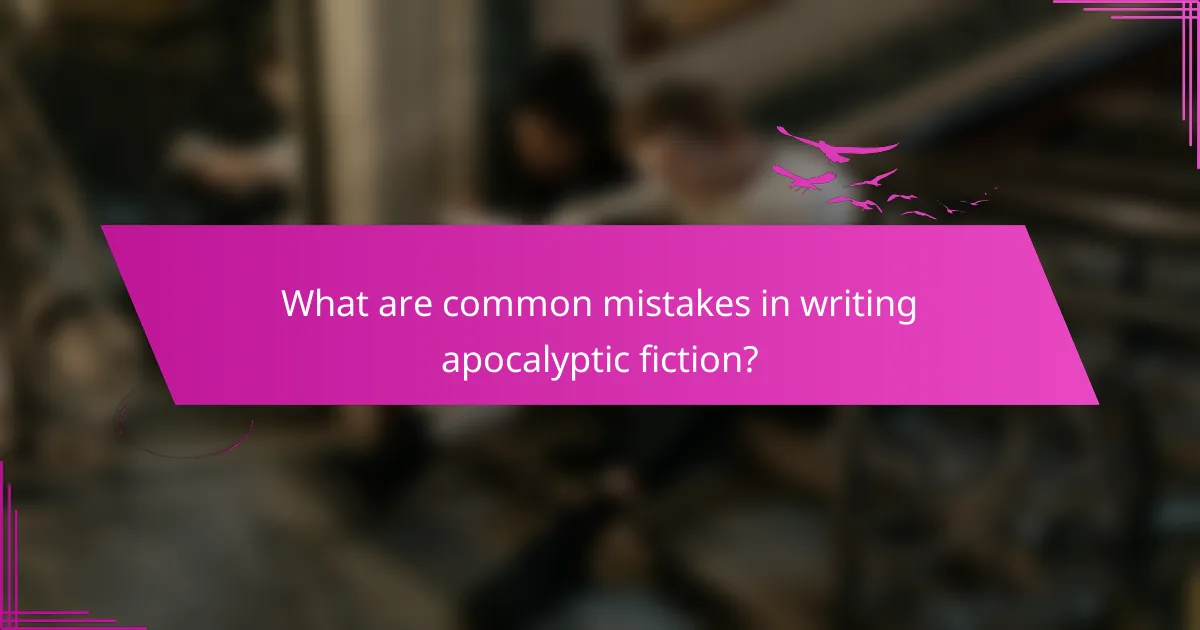
What are common mistakes in writing apocalyptic fiction?
Common mistakes in writing apocalyptic fiction include neglecting character development, overly focusing on destruction, and ignoring the psychological impact on survivors. Writers often fail to explore the balance between fear and hope, which diminishes the emotional connection with readers. Additionally, lack of realistic world-building can make the narrative feel unrelatable. Characters should reflect the complexities of human connection amid chaos, rather than merely serving as plot devices.
How can writers effectively balance fear and hope in their narratives?
Writers can balance fear and hope by creating relatable characters and scenarios that resonate emotionally. They should incorporate moments of vulnerability alongside instances of resilience. This duality fosters a connection with readers, emphasizing the human experience amid chaos. By portraying the struggle between despair and optimism, writers can inspire reflection and empathy. Engaging narratives often show characters overcoming obstacles, reinforcing hope even in dire circumstances. This balance enhances the psychological impact of apocalyptic fiction, making it more compelling and meaningful.
What strategies can enhance character connections in apocalyptic settings?
Creating strong character connections in apocalyptic settings relies on shared experiences and emotional depth. Strategies include building trust through collaboration, showcasing vulnerability, and emphasizing common goals. These elements foster empathy and create bonds that resonate with the audience. Unique attributes like personal backstories can further enhance these connections, making characters relatable and their struggles poignant. As a result, readers become more invested in their journeys.
Which best practices should authors follow to engage their audience?
Authors can engage their audience by creating relatable characters and exploring deep emotional themes. Building tension through fear and hope keeps readers invested. Incorporating human connection amid apocalyptic scenarios fosters empathy and reflection. Utilizing vivid imagery and sensory details enhances immersion, enabling readers to experience the narrative fully.
